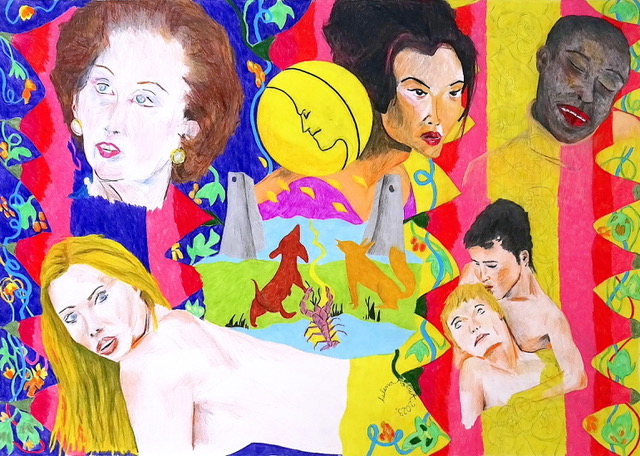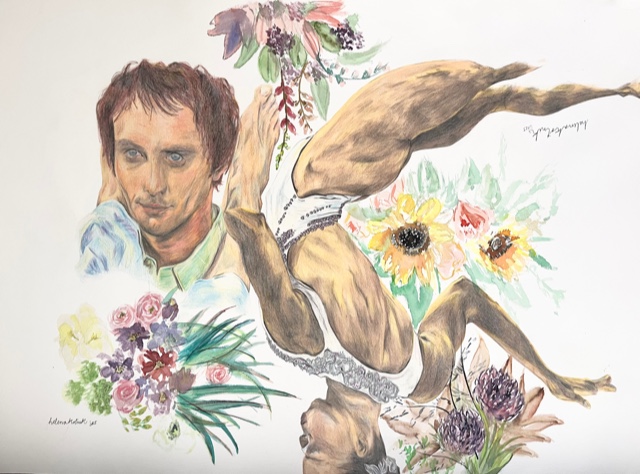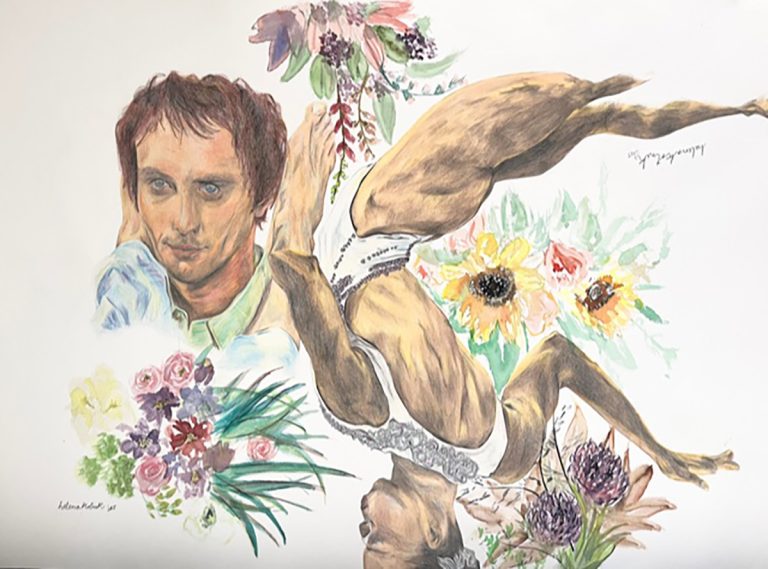Helena Kotnik, a graduate of Barcelona University and the Akademie der bildenden Künste in Vienna, is an artist who paints from within the human psyche. Her work has been described as “psychological human landscapes,” where color, form, and gesture reveal the invisible forces that shape our lives. Her style, both colorful and seemingly naïve, hides sharp insight beneath its surface. Influenced by artists across different periods in art history, Kotnik uses her canvases as mirrors—reflecting the world’s contradictions, humor, and fragility. Each work becomes a quiet commentary on what it means to live, connect, and remain human in a restless, ever-changing world.
Women (2025, 70x50cm, Pencil colors)

Women is a vivid portrayal of femininity as a living, breathing force. It’s not a single story but a constellation of experiences—each shape and color holding a fragment of womanhood. The composition feels both spontaneous and intentional, as if emotion itself guided the pencil. Bold colors overlap and vibrate, forming a rhythm that captures the contradictions of being female—strength and softness, resolve and vulnerability.
Kotnik doesn’t idealize her subject. Instead, she lets color and texture speak for themselves. The bright, almost childlike palette suggests freedom and curiosity, while the layering of hues adds complexity. Each color becomes a voice—some bright and laughing, others quiet and thoughtful. Together, they create a dialogue that feels deeply personal yet universal.
The figures—whether literal or abstract—don’t compete for attention. They coexist, sharing the same emotional space. In this coexistence lies the essence of the work: womanhood as collective experience. Kotnik’s women are not isolated portraits but echoes of one another. They carry traces of everyday life, emotion, and intuition.
The drawing’s energy feels cyclical, almost musical. The eye travels in loops, from one tone to another, tracing invisible connections between gestures. There’s no hierarchy here—no single “main character.” Instead, Kotnik invites the viewer to see womanhood as a web of interwoven selves.
At first glance, Women may appear celebratory, but beneath its vibrancy lies introspection. The brightness is balanced by subtle tension, as if Kotnik is acknowledging that femininity often exists within constraints—social, emotional, or historical. Yet, the overall tone is hopeful. The work doesn’t dwell on struggle; it honors resilience. It celebrates the everyday courage of women who adapt, create, and carry forward.
In this sense, Women is both a personal reflection and a cultural statement. It reclaims the act of drawing and coloring as something serious, meditative, and liberating. Kotnik turns what might seem playful into a profound emotional language—one that doesn’t need explanation to be understood.
On-tempo (2025, 100x70cm, Pencil colors and watercolor)

If Women is about collective identity, On-tempo is about the individual rhythm within it. This work feels like breathing—measured, grounded, alive. The title offers a clue: staying “on tempo” means being in sync with one’s own life, not rushing to match others. The painting captures that idea through its careful balance of stillness and motion.
Soft washes of watercolor meet the crisp lines of colored pencil. The interplay of media mirrors the tension between structure and flow. Watercolor moves freely, unpredictable and organic, while pencil anchors it, adding form and rhythm. The result is harmonious—neither chaotic nor rigid, just balanced in the moment.
Kotnik seems to be painting what it feels like to live consciously. The shapes pulse with quiet vitality, like notes in a melody that doesn’t need resolution. There’s no clear narrative, but there’s presence—a sense of someone listening inwardly.
The artist’s statement deepens this impression: “Moving in rhythm with your own timing instead of rushing or grabbing to meet others… staying on tempo then means adapting, not resisting.” This sentiment becomes visual here. Each color breathes. The spacing between forms feels intentional, like pauses in conversation. Even the white spaces seem active, giving the viewer room to rest and reflect.
On-tempo is less about external observation and more about inner alignment. It speaks to the desire for harmony in a world that moves too fast. Kotnik’s color choices—subdued yet glowing—evoke a calm resilience. There’s wisdom in her restraint. Rather than using intensity to grab attention, she uses rhythm to hold it.
This painting doesn’t shout; it hums. It’s about finding balance, letting change come, and moving with it rather than against it. Through pencil and watercolor, Kotnik translates mindfulness into image.
Both Women and On-tempo reveal her ability to turn abstract feeling into visual rhythm. Her art doesn’t try to explain life; it moves with it. In that movement, Helena Kotnik reminds us that being human is an art in itself—an ongoing act of listening, adapting, and staying true to one’s own beat.

